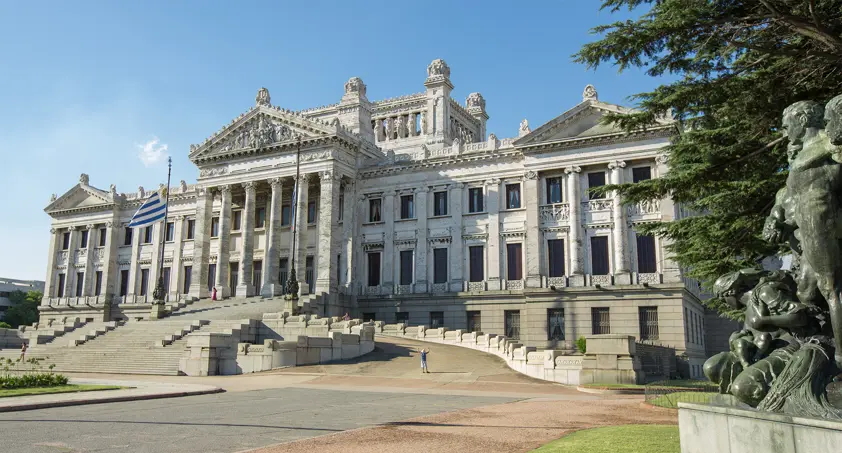Located in the southern half of South America, Uruguay is a sparsely populated democratic republic that is defined by its rolling plains, mild climate and strong institutions.
It is these institutions that have made Uruguay one of the most prosperous and stable countries in the region.
“In the late 19th century Uruguay began to implement a universal public education system, followed with social policies directed to strengthening the society,” says Carlos Steneri, former director of the debt management unit in Uruguay’s Ministry of Economy and Finance.
“Both factors, coupled with the presence of robust immigration flows from Europe – Spain and Italy mainly, led to the formation of a well-trained and productive workforce and the creation of a middle class. These aspects helped to promote values where democracy, the rule of law and strong institutions became fundamental,” says Steneri.
Uruguay is consistently ranked at the top of Latin America in terms of the strength of its democracy, the size of its middle class, its comparatively low levels of government corruption and for its high quality of life.
Education – the backbone of a strong economy
The country's per capita GDP and annual growth rate are both more than double the regional average. However, growth has slowed down in recent years, and both public and private investments are down compared with the previous decade.
Uruguay’s economy has traditionally been export-oriented, but a recent shift to added value and the services sector is helping to diversify the economy.
Even though the quality of primary and secondary education has deteriorated in recent years, the country maintains a well-educated workforce, which has allowed for expansion of the service sector.
This, along with free trade zones and political stability, has also made the country an attractive base for multinational corporations' regional headquarters.
The establishment and maintenance of Uruguay’s welfare state, through levying fairly high income and corporate taxes, has also helped the country achieve the lowest poverty and extreme poverty rates in Latin America.
“This gives you a good idea of the social balance of the country. Education, health care and social security are three elements that make the country very special,” says Enrique V. Iglesias, former Executive Secretary for the United Nations Economic Commission for Latin America and the Caribbean.
Rivers – the lifeblood of society
About 70% of Uruguay’s population lives along the country’s three major coasts: the Uruguay River, the Río de La Plata and the Atlantic Ocean. Montevideo, the capital, sits on the banks of the Río de La Plata and is home to 1.3 million residents.
One interpretation of the word Uruguay is the “river of the painted birds” due to the thousands of colourful species of native birds especially near the Uruguay River. Uruguay is also one of the few countries in Latin America where the entire population has access to clean water.
Laying claim to the title of the second smallest nation in South America at 176,220 square kilometres, surprisingly much of the north and centre of the country have large stretches of unpopulated land. This landscape is mostly dominated by rolling plains which represent a transition from Argentina’s pampas to Brazil’s hilly uplands.
The purpose of land is a land of purpose
Uruguay is unique among South American countries due to the precise nature of the government’s central planning for land use. It is the only country on the continent in which the land is divided according to how suitable it is for certain activities.
“That was extremely useful once we realised that certain pieces of land could only be used most economically for certain activities. This has economically benefited the country,” says Iglesias.
Most Uruguayan land is used as pasture for sheep and cattle. Beef, milk and combed wool are among the country’s main exports.
Around 5% of Uruguay’s land is covered by native forests which are all protected. However, recent investments in the forestry sector have led to an increase in forest cover. About 7% of the land is arable. Uruguay also exports rice, soybeans and pulp. The latter two have become the country’s two largest exports and in 2018 pulp took pole position. For the first time in Uruguay’s history a product other than beef was leading exports.
Conservation is a state of harmony
Due to its small size and lack of heavy industry, Uruguay is not a major emitter of greenhouse gases, but has a vested interest in mitigating the effects of climate change. Most of the country, including Montevideo, is at sea level.
According to German Ríos, the representative of the Development Bank of Latin America in Uruguay, entities such as his are increasingly focused on investing in sustainable business projects. These include low-carbon infrastructure, sustainable transportation and renewable energy projects.
“About 98% of Uruguay’s power generation is renewable, of which 26% is wind energy. Five years ago, that number was zero,” says Ríos.
Also the share of biomass in Uruguay’s energy matrix has grown in recent years to about 20%. Created in the boilers of pulp mills, biomass-based energy is renewable and provides a predictable and stable power supply.
In 2014, Uruguay was named by the WWF as one of the “Green Energy Leaders” in Latin America.
Text: Daniel Dawson

